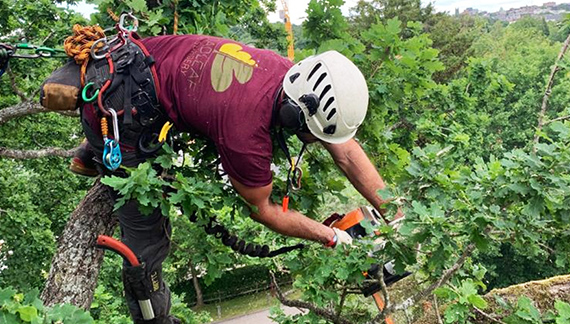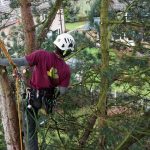Trees and shrubs are an essential part of the modern British garden. Providing shade, structure and diversity to all aspects of your outside space, trees and shrubs can also pose a risk to your property if they are allowed to overgrow. Here at Broadleaf Tree Surgery, we want to give you our essential guide for maintaining your trees and shrubs, ensuring their health and longevity. This will ensure that you and your outside flora can live happily together for years to come.
So, when is the best time to cut back your trees, shrubs or plants? The plant’s dormant period is the best time to prune. Many common British garden trees and shrubs have different requirements that must be considered. These considerations should be on the plant’s species, growth stage, size, health and your reason for pruning.
Contents
- 1 What Is Pruning?
- 2 When To Prune Your Trees
- 3 Pruning With Broadleaf Tree Surgeons
Here are our essential top tips for any level of gardener, from those who are just getting started to the green-thumbed seasoned gardener. But first let’s address pruning in a general sense, which will help us understand our impact on the plants we are about to work on.
What Is Pruning?
Pruning is simply cutting or clearing specific branches from parts of your plant to improve its appearance, health or structure. This process not only improves the growth of the tree by removing unhealthy branches or leaves, but it also may prevent overgrown branches from imposing a safety risk below or towards a nearby property. Removing branches not only improves the way your garden looks and works but also helps prevent diseases such as ‘ash dieback’.
Some trees, such as conifers, don’t recover well from being badly pruned. Others such as gorse or other hardy plants can stand more indiscriminate pruning.
When To Prune Your Trees
Some plants or trees benefit from summer pruning where they can recover from being pruned in ample sunshine. Many others however prefer being pruned in their dormant periods, notably winter, where they go into a hibernation-like state when sunlight is scarce.
Species | Optimal Time To Prune |
|---|---|
| Deciduous | |
| Acica | Spring (Late) |
| Apple | Winter (Mid) |
| Ash | Spring to Summer (Late) |
| Birch | Summer to Winter (Mid) |
| Beech | Summer (Late) to Autumn |
| Elm | Spring (Late) to Summer |
| Oak | Autumn to Winter |
| Evergreen | |
| Cedar | Winter (Mid to Late) |
| Cypress | Spring (Late) to Summer (Early) |
| Fir | Spring (Late) to Summer (Early) |
| Hemlock | Summer (Late) |
| Pine | Spring (Late) |
| Spruce | Summer (Late) |
| Yew | Summer (Late) or Winter (Late) |
Plants grow dormant in the winter periods to prevent water intake, which would freeze in the plants’ branches and cause hardness to the bark’s outer layer. Understanding your plants’ requirements when it comes to dormancy will allow you to best assess when to prune it and leave it in good health going forward. Pruning later in the plant’s dormant period can ensure the plant can use spring and grow accordingly.
Professional Pruning and Crown Thinning with Broadleaf Tree Surgery
Set your trees up for healthy growth with our professional tree pruning services. Our team is passionate about all things tree care and will be able to advise on the best work to keep your trees healthy and keep your garden neat. Our pruning services include crown thinning, crown lifting, and full crown reductions.
When Is The Best Time To Prune Fruit Trees?
The best time of year to prune fruit trees is late winter into early spring. This is when the trees will be least affected by winter hardiness and won’t damage the tree’s health. Winter pruning encourages vigorous growth and improves shoots on your tree, particularly for apples, pears and quince.
Stone fruits, cherries, plums, peaches and apricots should be pruned during early spring. Spring pruning encourages the tree to produce a higher fruit crop, allows the air and light into the canopy and prevents your trees from becoming too big.
When Is The Best Time To Prune Deciduous Trees?
As they become dormant, many deciduous trees should be pruned during the winter months. This allows them to heal from the damage the pruning does and allows for more robust growth in the new spring.
There are some exceptions to this, such as birch and maple trees. They require pruning in autumn or early winter to prevent heavy bleeds from the cuts.
Magnolias and walnut trees need pruning between mid-summer and early autumn as this prevents bleeds in the tree and allows them to heal well. With deciduous trees, it’s important to be aware that over-pruning should be avoided as your trees could double their growth and end up with more tree rather than less.
When Is The Best Time To Prune Evergreens?
Evergreen trees may be best only pruned if doing so is needed to remove diseased or dead branches or maintain the shape of the plant. If the tree or shrub requires pruning, it’s best to do this in late winter or early spring before the new growth begins, so the plant has a good chance to recover.
Springtime is ideal for light pruning to encourage the buds to grow further down the stems. Late summer is more suitable for harder pruning to create the shape and size of the plant. Once you have pruned, feeding and mulching your trees is important to keep encouraging new growth throughout the season.
When Is The Best Time To Prune Conifers?
Conifers are a diverse range of cone-bearing seed plants that grow all over the UK and the Northern Hemisphere. They are a subset of Gymnosperm. All extant conifers are considered to be perennial woody plants which exhibit secondary growth. This means that conifers will continue to grow wider as they age, which is why they are a favourite of tree surgeons and gardeners wanting to fill lateral space in their outside areas. This also means that they can become oversized almost yearly.
Common British varieties such as the Leyland Cypress require little intervention in terms of their growth. If you do wish to prune your conifer, however, then it is best carried out between April and August. This will ensure the plant has ample conditions during the growing season to recover from being pruned.
Brown patches are often a result of over or indiscriminate pruning or they usually indicate poor plant health. Conifers should be green all year round; the green outer layer is indicative of a healthy, happy conifer. When pruning, you should be active in ensuring the plant has sufficient green, chlorophyll-rich pines on its outer coat, which will give the tree a chance to recover.
As a rule of thumb, when pruning, if you break through this outer layer of healthy pines, you will hit a brown inner layer. This indicates that you have over-pruned and it should be avoided.
When To Prune Ash Trees
Ash trees reportedly make up between 12% and 16% of all tree coverage in the UK. This incredibly important species of tree suffers from a condition known as ‘Ash dieback’, a fungal disease that was first spotted in 2012 in the UK. This should be your main consideration when pruning ash. Caused by fungal spores which attack open cuts on ash trees, dieback can be recognised by symptoms including;
- leaves with dark patches during the summer months;
- tip dieback in mid-summer usually to the next growth point;
- wilting leaves and early leaf drop;
- epicormic growth from beneath the canopy i.e dormant buds are activated;
- lesions on the bark which are typically dark brown and forming on side laterals.
‘Ash dieback’ has been forecast to kill 80% of all UK ash. It is imperative that anyone who wishes to prune ash on their property does so with caution or seek professional advice from a tree surgeon. You can also consult our dedicated blog on this condition before your pruning work to give you the best chance of preventing this disease.
To reduce the time when the tree will be exposed to ash dieback, it is strongly advised that you prune late in the dormant period so the plant can quickly heal from being cut, late October to early March is ideal.
When Is It Best To Trim Gorse?
The end of May is the ideal time to trim gorse. We recommend you wait until the yellow flowers have started to fade as the plant will only then be less populated with insects. You should only need to cut-back gorse once every year to two years unless it poses any immediate risk. Animals love nesting in gorse, so make sure to check thoroughly before carrying out any work on the plant.
Gorse has picked up popularity in recent years as it provides safe habitation to a variety of birds and insects. Often misunderstood to be a hostile plant, gorse can be tricky to prune as it has many sharp spikes on each branch making even the most careful of gardeners take extra care. We love gorse, a surprising member of the pea family, the beautiful yellow flowers inhibit a slight coconut aroma. Gorse can be found across meadows, moorland or coastal regions around our native Kent and the rest of the UK.
Pruning With Broadleaf Tree Surgeons
Pruning is an important maintenance task that can help improve the health and structure of any plants, trees and shrubbery on your property. It’s important to consider not only the species of tree you are about to prune but also the tools which you are going to use to carry out the task.
As discussed, the dormant season is our busiest time of year as tree surgeons so it’s the best time to plan to have professional tree surgery carried out early in advance. To get the most out of your trees and outside area, having professionals carry out the work keeps everyone safe when using dangerous tools at height.
If you need assistance or just want to get the most out of your trees now and in the future, get in touch with Broadleaf Tree Surgery to carry out professional work on your trees, plants or shrubs today.



